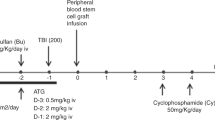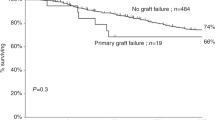Summary:
Allogeneic hematopoietic stem cell transplantation (SCT) from unaffected donors remains the only modality for the correction of hematological abnormalities in Fanconi anemia (FA) patients. We performed four HLA-matched related donor SCT using a novel irradiation and cyclophosphamide-free conditioning regimen. The protocol included fludarabine 150 mg/m2, busulfan 4 mg/kg, and antithymocyte globulin 90 mg/kg. Graft-versus-host disease (GVHD) prophylaxis was cyclosporin A, MTX, and daclizumab. The engraftment and occurrence of full stable donor hemopoiesis was rapid in all cases with minimal short-term toxic complications. There were no infections or febrile episodes during the inpatient phase. Three patients developed acute GVHD grade I–II involving gut and skin and one patient progressed to extensive chronic GVHD. The preparative conditioning regimen is safe and associated with low organ toxicity and effective immunosupression for the stable engraftment in FA patients undergoing SCT with matched related donors.
This is a preview of subscription content, access via your institution
Access options
Subscribe to this journal
Receive 12 print issues and online access
$259.00 per year
only $21.58 per issue
Buy this article
- Purchase on Springer Link
- Instant access to full article PDF
Prices may be subject to local taxes which are calculated during checkout
Similar content being viewed by others
References
Young N, Alter B (eds.). Clinical features of Fanconi's anemia. In: Aplastic Anemia, Acquired and Inherited. Saunders: Philadelphia, 1994; pp 275–309.
Sasaki M, Tonomura A . A high susceptibility of Fanconi's anaemia to chromosome breakage by DNA cross-linking agents. Cancer Res 1973; 33: 1829–1836.
Gluckman E, Devergie A, Dutreix J . Radiosensitivity in Fanconi anaemia: application to the conditioning regimen for bone marrow transplantation. Brit J Haematol 1983; 54: 431–440.
Gluckman E, Auerbach A, Horowitz M et al. Bone marrow transplantation for Fanconi anemia. Blood 1995; 86: 2856–2862.
Socie G, Devergie A, Girinski T et al. Transplantation for Fanconi's anaemia: long-term follow-up of fifty patents transplanted from a sibling-donor after low-dose cyclophosphamide and thoraco-abdominal irradiation for conditioning. Br J Haematol 1998; 103: 249–255.
Kurre P, Pulspipher M, Woolfrey A et al. Reduced toxicity and prompt engraftment after minimal conditioning of a patient with Fanconi anemia undergoing hematopoietic stem cell transplantation from HLA-matched unrelated donor. J Pediatr Hematol/Oncol 2003; 25: 581–583.
de la Fuente J, Reiss S, McCloy M et al. Non-TBI stem cell transplantation protocol for Fanconi anaemia using HLA-compatible sibling and unrelated donors. Bone Marrow Transplant 2003; 32: 653–656.
Flowers M, Zanis J, Pasquini R et al. Marrow transplantation for Fanconi anemia: conditioning with reduced doses of cyclophosphamide without radiation. Br J Haematol 1996; 92: 699–706.
Rossi G, Giorgiani G, Comoli P et al. Successful T-cell-depleted, related haploidentical peripheral blood stem cell transplantation in a patient with Fanconi anaemia using a fludarabine-based preparative regimen without radiation. Bone Marrow Transplant 2003; 31: 437–440.
Kapelushnik J, Or R, Slavin S, Nagler A . A fludarabine-based protocol for bone marrow transplantation in Fanconi's anemia. Bone Marrow Transplant 1997; 20: 1109–1110.
Aker M, Varadi G, Slavin S, Nagler A . Fludarabine-based protocol for human umbilical cord blood transplantation in children with Fanconi anaemia. J Pediatr Hematol/Oncol 1999; 21: 237–239.
Dufour C, Rondelly R, Locatelli F et al. Stem cell transplantation from HLA-matched related donor for Fanconi's anaemia: a retrospective review of the multicentric Italian experience on behalf of Associazione Italiana di ematologia ed oncologia pediatrica (AIEOP)-Gruppo Italiano trapianto di midollo osseo (GITMO). Br J Haematol 2001; 112: 796–805.
Champlin R, Horowitz M, van Bekkum D et al. Graft failure following bone marrow transplantation for severe aplastic anaemia: risk factors and treatment results. Blood 1989; 73: 606–613.
Guardiola P, Pasquini R, Dokai I et al. Outcome of 69 allogeneic stem cell transplantations for Fanconi anemia using HLA-matched unrelated donors: a study on behalf of the European Group for Blood and Marrow Transplantation. Blood 2000; 95: 422–429.
Author information
Authors and Affiliations
Corresponding author
Rights and permissions
About this article
Cite this article
Maschan, A., Trakhtman, P., Balashov, D. et al. Fludarabine, low-dose busulfan and antithymocyte globulin as conditioning for Fanconi anemia patients receiving bone marrow transplantation from HLA-compatible related donors. Bone Marrow Transplant 34, 305–307 (2004). https://doi.org/10.1038/sj.bmt.1704580
Received:
Accepted:
Published:
Issue Date:
DOI: https://doi.org/10.1038/sj.bmt.1704580
Keywords
This article is cited by
-
Outcome of hematopoietic stem cell transplantation (HCT) from HLA-matched related donor for Fanconi anemia (FA) in adolescents and adults: a retrospective study by Eastern Mediterranean Blood and Marrow Transplantation Group (EMBMT)
Bone Marrow Transplantation (2020)
-
Hepatotoxicity induced by horse ATG and reversed by rabbit ATG: a case report
Journal of Medical Case Reports (2007)



